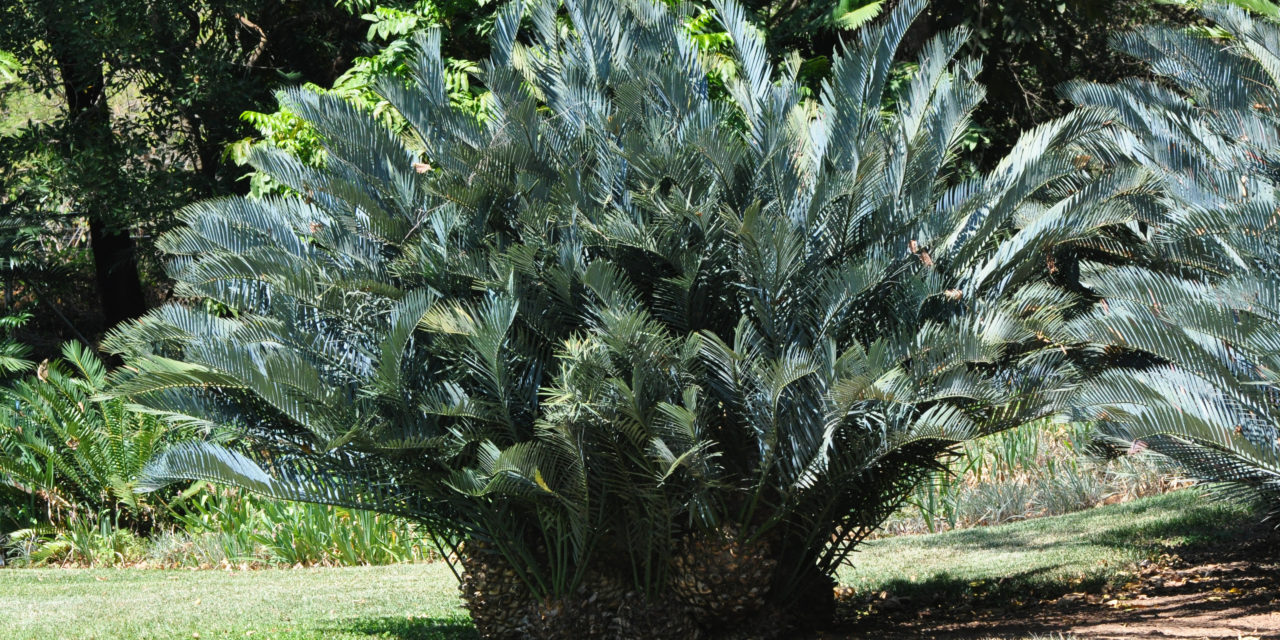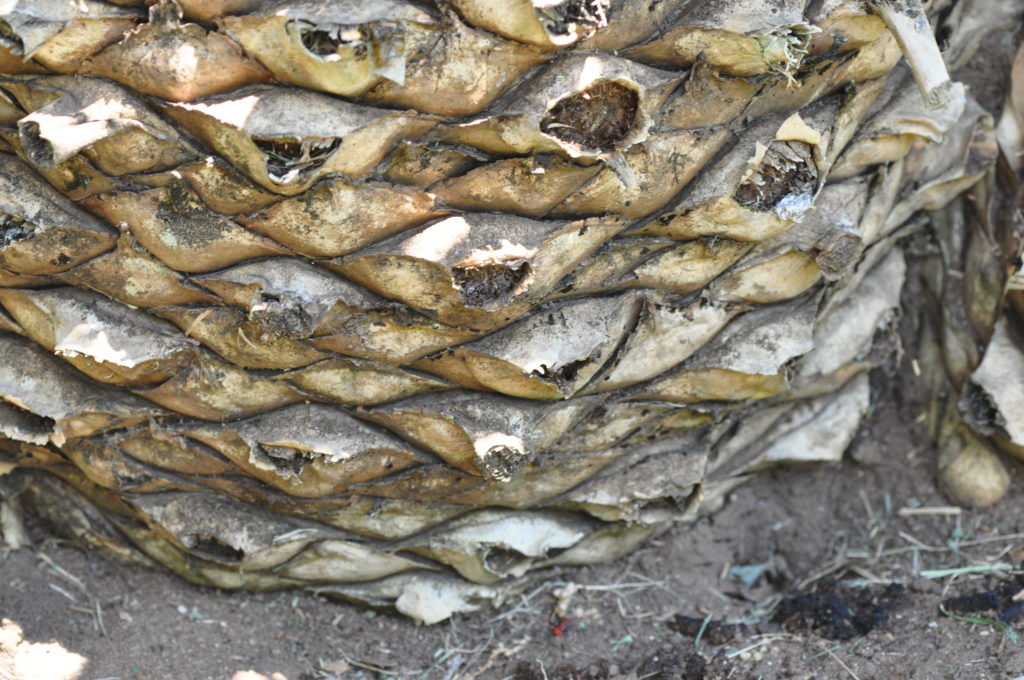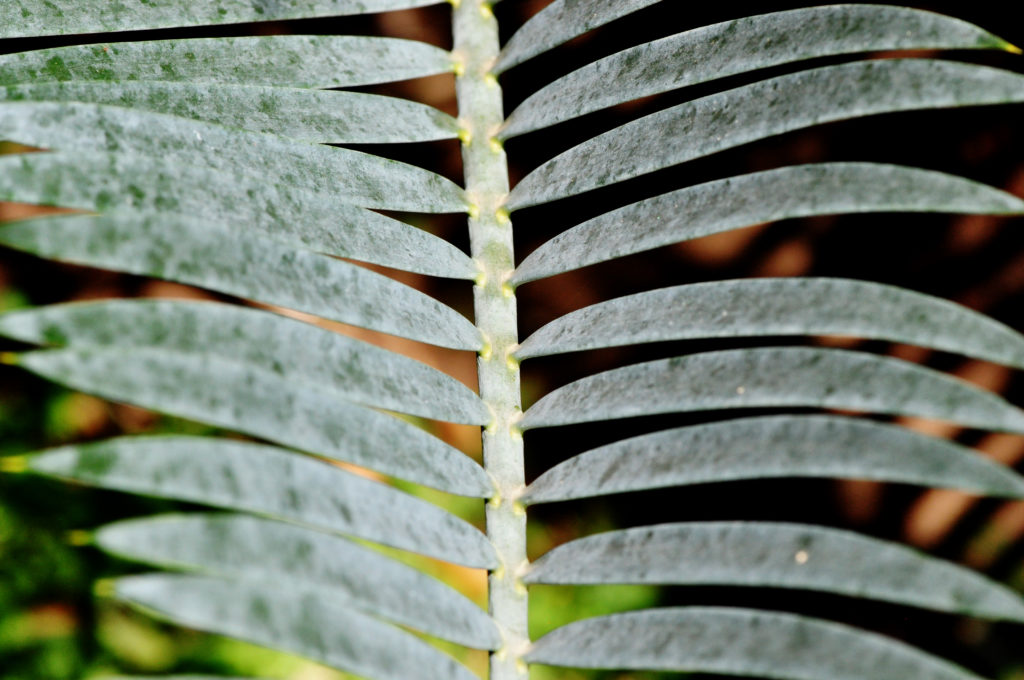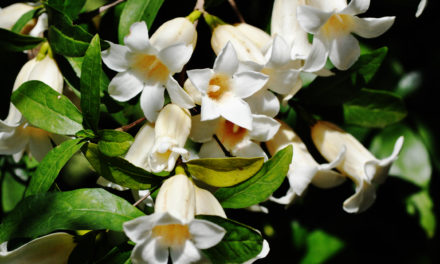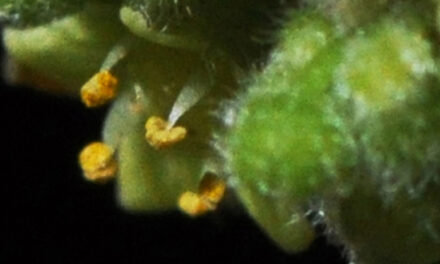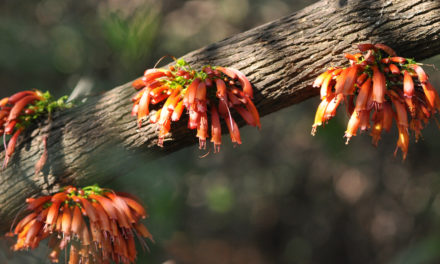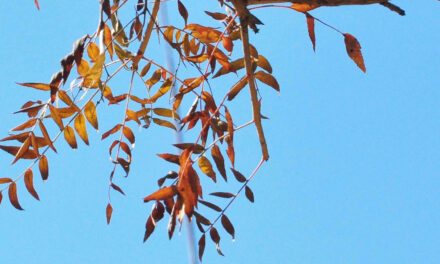General Info – summary
This dioecious, possibly multi-stemmed Tree with its sturdy trunk, may recline, reach 2m long, and have a diameter of up to 45cm. Leaves are silvery blue to green, pinnately compound & central leaflets do not overlap. All greenish Cones are solitary. Male cones develop motile sperm and the larger female cones produce naked seeds. Insect pollinators are beetles. The poisonous red Seeds are up to 5 x 2cm.
Description
Encephalartos lehmannii
SA Tree No. 8.1.
Common names: (Afr) Broodboom, Karoo-broodboom. (Eng) Bread Palm, Bushman’s River Cycad, Karoo Cycad.
Family: Zamiaceae. This family is part of the major group: Gymnosperms. They are cone-bearing plants producing naked seeds and include Ginkgo, Cycads Conifers and Gnetophytes: e.g., Welwitschia mirabilis (tweeblaarkanniedood). Members have no flowers or fruit, and the seeds are often contained in Cones. The gymnosperm family Zamiaceae has 9 genera including Encephalartos (cycads). The African plants in the genus Encephalartos include about 66 species and 35+ of these occur in southern Africa.
Name derivation: Encephalartos – within-head-bread: referring to the starchy bread that can be made from the pith of the inner trunk. lehmannii – named after Johann Georg Christian Lehmann (Prof) a German botanist who described several species of Cycad in 1834. He created the Genus Encephalartos.
Family: Zamiaceae. This family is part of the major group: Gymnosperms. They are cone-bearing plants producing naked seeds and include Ginkgo, Cycads Conifers and Gnetophytes: e.g., Welwitschia mirabilis (tweeblaarkanniedood). Members have no flowers or fruit, and the seeds are often contained in Cones. The gymnosperm family Zamiaceae has 9 genera including Encephalartos (cycads). The African plants in the genus Encephalartos include about 66 species and 35+ of these occur in southern Africa.
Conservation: National Status: N T (Near Threatened). Assessment: 2009. J.S. Donaldson. Problem factors include grazing by goats, illegal harvesting and porcupine trunk damage.
Tree
Species of Encephalartos (Cycads) are only superficially palm or fern like and are usually unbranched. The cycad tap Root is usually soon replaced by lateral roots, which become woody. Cycads have Coralloid Roots that contain symbiotic cyanobacteria (blue-green algae) that fix atmospheric nitrogen. Through a process of complex biological pathways, the cyanobacteria convert atmospheric molecular nitrogen into compounds such as ammonia, and amino acids needed by the cycads. The trunk on this short, sturdy, silvery blue Tree is up to 2m long and often reclines. Groups of up to 10 stems may develop together (see intro. photo) and individual trunks may reach a diameter of up to 45cm. Shortly persistent Petioles (leaf bases) initially cover the trunk before falling and leaving papery Leaf Scars behind (photo 880).
- Photo: David Becking.
Leaves
Only leaf scars eventually remain on the trunk once the whole leaves fall. Unlike other members of the family Zamiaceae, the cycads have leaflets that lack a central Midrib (vein). The hard leaflets do not bend easily and the sunken Veins are parallel. Stomata (structure utilising 2 guard cells that, unlike lenticels, can control gaseous exchange) are present on the lower surface and may occur above.
Cycads are unique Gymnosperms with pinnately compound Leaves (leaflets are arranged along either side of the leaf Rachis – the central stalk – like a feather). These Young leaves are distinctly silver-blue. Mature leaves become blue-green and each leaf is up to 1,4m long. The ends of the leaves may be recurved. The Petiole (leaf stalk) is up to 25cm long. The base of the petiole has a distinctive yellow collar. Petiolules (leaflet stalks) are absent. A small yellow collar is present where each Leaflet joins the leaf rachis (photo 879E). The middle leaflets do not overlap and towards the leaf end, are almost horizontal (photo 879). A cross section of the Rachis (extension of the petiole of a compound leaf that eventually bears the leaflets) closer to the petiole has adjacent leaflets in a V-shape. At the base of the rachis, the leaflets may be reduced to paired spines. The leaf Margin is either entire (with a continuous margin, not in any way indented) or, small spines may be present on the lower margins.
- Photo 879: David Becking.
- Photo 879E: David Becking.
Cones
All Gymnosperms have unenclosed or naked seeds. They have no flowers or fruit and the seeds are often contained in cones. In the Angiosperms (flowering plants), the seeds are enclosed in an ovary. In the Gymnosperms, there are 2 modes of fertilization. In all the Cycads (including Encephalartos) and the single extant (not extinct) species of Ginkgo biloba, the male cones produce motile sperms. The remaining members of the Gymnosperms all have non-motile sperm with no flagella and are moved along with a Pollen tube to the egg. All species of cycads produce Motile Sperm, which do not move along a pollen tube.
Like all cycads, Encephalartos lehmannii is Dioecious (having male and female cones on separate plants). These cones develop in the centre of the leaf whorls. Neither male nor female cones occur every year and they are somewhat dependant on the weather. All Cones on this cycad are single and bluish green. Young cones have fine, dark hairs that cause them to look blackish. These hairs are lost at maturity. The almost cylindrical Male cones are up to 35 x 10cm, and rest on a Peduncle (a short stalk) and their colour is revealed once the hairs disappear. Pollen is located in sacs below each of the cone-scales. The barrel-shaped Female cones are larger and up to 50 x 25cm. Like the male cones, the colour becomes apparent once the cones mature. The tree is insect pollinated and Beetles (Coleoptera) have been identified as the most common pollinators of cycads. At maturity, Seeds are released when the Female cones disintegrate. Two red seeds are produced on the upper side of each female cone scale. Each Seed is about 5 x 2cm. Monkeys and baboons disperse the seeds, which germinate with small amounts of water.
Distribution & Ecology
This cycad is a survivor and is reputed to be the most drought resistant cycad in South Africa. They occur in the Namib (a coastal desert) and succulent Karoo as well as Albany thickets (dense impenetrable thickets in Eastern Cape). Cone production is somewhat rain dependent and usually do not develop each year. This plant is Endemic (Endemism is the ecological state of a species being unique to a defined geographic location) in the dry interior of the Eastern Cape of South Africa. This includes the Sundays and the Groot River valleys. The source of the Sundays River is in the Sneeuberge (snow mountain) in the Eastern Cape, with a 250km long drainage area. Here the cycads are more or less isolated in non-coastal sandstone outcrops in dry almost grassless areas where they seldom experience fires. These plants are frost resistant and exceptionally drought resistant – growing in areas with less than 360mm of rain per year. This results in their occurrence further west than most cycads. Dassies (the closest living relative to the African elephant despite being rabbit sized) eat the fruit. Trees associated with this cycad include Searsia undulata, Diospyros scabrida and Nymania capensis. This cycad closely resembles E. princeps but is shorter and its location is closer to the sea.
Ethnobotany
Grow these plants in full sun, in well-drained areas. Do not over-water. One author recommends using a fertilizer having an even NPK (Nitrogen, Phosphorus, Potassium) balance, with supplemental trace elements to provide a good start for cycads. These plants will grow from seeds or suckers. Both male and female plants are required for seed production, thus choosing the suckers is the best way to go. Grazing animals including goats consume the leaves and porcupines damage the stems. All seeds produce carcinogenic and neurotoxic glycosides (cycasins). These are poisonous to mammals, including man. Always wear gloves when handling seeds.
References
Boon, R. 2010. Pooley’s Trees of eastern South Africa. Flora and Fauna Publications Trust, Durban.
Coates Palgrave, M. 2002. Keith Coates Palgrave Trees of Southern Africa. edn 3. Struik, Cape Town.
Donaldson, J.S. 2009. Encephalartos lehmannii Lehm. National Assessment: Red List of South African Plants version 2020.1. Accessed on 2023/04/12.
Lawrence, G. H. M, 1951. Taxonomy of Vascular Plants. The Macmillan Company, New York. Tenth Printing 1965.
Palmer, E. & Pitman, N. 1972. Trees of southern Africa. Balkema, Amsterdam, Cape Town.
http://biodiversityadvisor.sanbi.org/wp-content/uploads/sanbi-identify-it/plants/encephalartos.htm
http://www.theplantlist.org/browse/G/Zamiaceae/
https://www.diffen.com/difference/Angiosperms_vs_Gymnosperms
http://www.botanicwonders.com/Feature-Encephalartos-lehmannii.htm
http://cycadsociety.org/?page_id=1808
http://www.wild-about-you.com/AfricaCycads.htm

